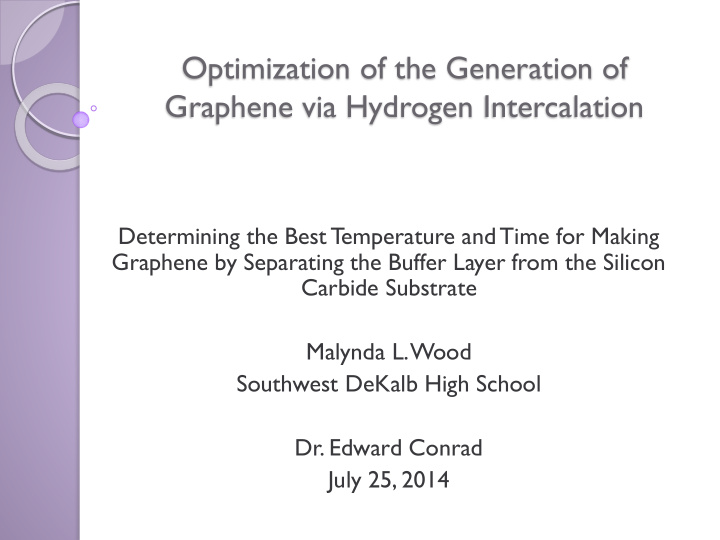



Optimization of the Generation of Graphene via Hydrogen Intercalation Determining the Best T emperature and Time for Making Graphene by Separating the Buffer Layer from the Silicon Carbide Substrate Malynda L. Wood Southwest DeKalb High School Dr. Edward Conrad July 25, 2014
Problem Prior samples intercalated at1100 o C damaged Needed best temperature and time to get undamaged samples
Graphene Two dimensional structure One atom thick Strong Conductive "Graphen" by AlexanderAlUS - Own work. Licensed under Creative Commons Attribution-Share Alike 3.0
Buffer Layer Buffer layer between substrate and graphene on silicon face Buffer layer is structurally similar to graphene that is covalently bonded to the substrate Hydrogen intercalation can break the covalent bonds between silicon and the buffer layer Converts the buffer layer to quasi-free- standing graphene
Research Objective Determine optimum method of obtaining graphene through hydrogen intercalation by ◦ Determining optimum temperature ◦ Determining optimum time
Methodology Intercalation process ◦ First Nano Graphene Furnace ◦ 600 torr H 2 ◦ H 2 99.999% purity ◦ 900 sccm flow rate
Methodology Samples intercalated for 2 hours at : ◦ 700 C ◦ 800 C ◦ 900 C ◦ 950 C ◦ 1000 C
Methodology ◦ Samples intercalated for 3 hours at: 700 C 900 C ◦ Sample intercalated for 10 min at 900 C ◦ All samples evaluated by Raman Spectroscopy
700 C 800 C 900 C 950 C 1000 C
Findings Of the temperatures tested 900 C provided the best results Of the times tested 10 minutes produced the best results
Next Steps Further experiments on finding the best time Determining if these times and temperatures also apply to etched samples and nanoribbons
Lesson Plan Resistance ◦ Conductors vs Insulators ◦ Factors affecting resistance Resistance on a wire simulations Resistance on a wire lab Research paper on Graphene
I thankfully acknowledge the following for their invaluable assistance National Science Foundation Grant (DMR1005880) Dr. Ed Conrad Feng Wang Matthew Conrad Katie Jenkins Meredith Nevius John Pham
Recommend
More recommend